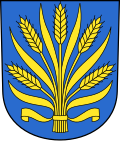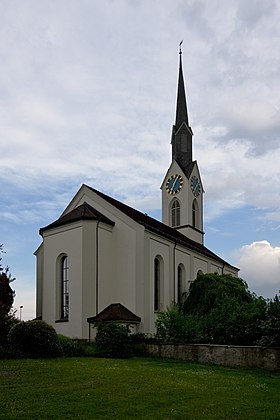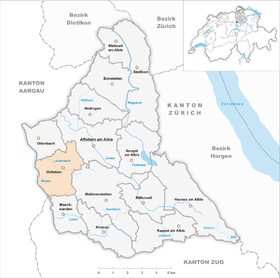Obfelden
| Obfelden | |
|---|---|
| State : |
|
| Canton : |
|
| District : | Affoltern |
| BFS no. : | 0010 |
| Postal code : | 8912 |
| Coordinates : | 674 586 / 235 275 |
| Height : | 430 m above sea level M. |
| Height range : | 383-520 m above sea level M. |
| Area : | 7.54 km² |
| Residents: | 5599 (December 31, 2018) |
| Population density : | 592 inhabitants per km² |
|
Proportion of foreigners : (residents without citizenship ) |
20.9% (December 31, 2018) |
| Mayor : | Thomas Ammann ( FDP ) |
| Website: | www.obfelden.ch |
|
The church in Obfelden seen from the cemetery |
|
| Location of the municipality | |
Obfelden (Swiss German: Obfael ) is a municipality in the Affoltern district in the canton of Zurich in Switzerland . The community consists of the villages Unterlunnern , Oberlunnern , Wolsen , Toussen and Bickwil and the after cleavage from Ottenbach resulting Chile field (Swiss German Underlunnere , Oberlunnere , Wolse , tousse , Bickwiil , Chilefäld ).
geography
Obfelden belongs to the Knonaueramt and lies on the Reuss , which forms the canton border with the canton of Aargau . The community also borders the Canton of Zug in the south . The air distance to Zurich is about 14 kilometers, to Zug about 13 kilometers.
Neighboring communities are Ottenbach , Affoltern am Albis , Mettmenstetten , Maschwanden , Hünenberg , Merenschwand .
history
The first settlements in Obfeld can be traced back to the Stone Age . Finds suggest a Neolithic settlement. Bronze bangles from the 7th century BC BC indicate a Celtic settlement. At the time of the Romans there was a small vicus with central buildings and probably with harbor facilities on the Reuss below today's hamlet Unterlunnern . The settlement name Lunnern (perhaps of Celtic-Latin Londinaria ) witness to a cultural contact between Romansh -speaking populations and extends. Colonizing from the 7th century. N. Chr Alemanni . So far, excavations have only taken place in the form of random samples. However, the gold treasure of Unterlunnern was discovered as early as 1741 : The hoard from the end of the 3rd century AD is in the Swiss National Museum in Zurich.
From the 7th to the 11th centuries, five hamlets emerged in what is now the municipality: the Unterlunnern and Oberlunnern, which are linked to the ancient Lunnern, and - a little further from the Reuss - Toussen (perhaps from Old High German Duninesheim , "Heim / Dorf des Duni", first documented 1325 as Tunsen ) Wolsen perhaps (from Old High German hovun ze Wolines , "the Woli in the courts", mentioned in 1218 as Woloshoven and 1311 as Wolunsun ) and Bickwil (probably from Old High German wilari Biccin , "Weiler of BICCO" in 1150 as Biggwile occupied ).
Ecclesiastically, the hamlets have belonged to Ottenbach since the end of the High Middle Ages . In court they were partly subordinate to the Maschwanderamt, partly to the Freiamt Affoltern and fell with these areas to the city of Zurich in 1406 and 1415 respectively. In the second half of the 15th century they were directly affected by the Old Zurich War , and in the third decade of the 16th century as part of the Knonau Bailiwick , which was created as a new administrative unit in 1507, they were involved in the events surrounding the Zurich Reformation. For the first time in 1640, the then Ottenbach priest Hans Kaspar Müller summarily called the five hamlets "gmeinden ob dem feld". In 1651 the same pastor wrote in a letter to the Zurich authorities: "The upper parishes, however, seriously insist that they should be given a school over the field, [...]."
From the middle of the 17th century onwards, economic crises and population growth meant that numerous residents of the Knonaueramt were forced to emigrate. The names of almost 350 people who emigrated abroad from Obfelden between 1650 and 1750 have come down to us, about a third of whom moved to Alsace and the rest to the Duchy of Zweibrücken, the Electoral Palatinate, Brandenburg or the American Pennsylvania.
On February 15, 1847, the five civil parishes separated above the field of Ottenbach and founded the new unified municipality Obfelden. The cotton and silk manufacturer Rudolf Stehli-Hausheer (1816–1884), who addressed this matter in 1846 with a letter to Alfred Escher , played a decisive role in this spin-off . The later liberal National Council and railroad promoter founded a cotton weaving mill in Oberlunnern in 1837 and converted it into a silk weaving mill, later called Stehli Seiden , in 1840 . This was the beginning of the industrialization of the village.
In the year the community was founded, the battle of Lunnern took place on November 12, 1847 as part of the Sonderbund War , during which the Sonderbund groups tried in vain to cross the Reuss into the Zurich area.
In 1847, the church architect Ferdinand Stadler provided the plans for a church in the village, the construction of which was largely financed by the silk patron Stehli-Hausheer. In the vicinity of the church and rectory, the hamlet of Chilenfeld was built in the following decades , in which also the country estate of the factory owner family, the so-called Villa Stehli (1877), the new school buildings (secondary school 1885, gym 1892, primary school 1897) and the parish hall ( 1929) came to a standstill.
coat of arms
- In blue, a bundle of five golden ears of corn, which alternate with six golden leaves, held together by a golden ribbon with free fluttering ends.
The ears of wheat symbolize the five hamlets.
Attractions
There are two churches in Obfelden:
- the Reformed Church from 1847 and
- the Roman Catholic Church of St. Anthony from 1965.
traffic
The community is served by three bus routes: Affoltern am Albis - Ottenbach (212 via Dorfstrasse, 213 via Bickwil) and Affoltern am Albis - Muri (217 via Dorfstrasse). Since November 13, 2009, the community has had a joint motorway connection with Affoltern am Albis.
Personalities
- Andreas Gut (documented 1557–1589), author of the text « Teüffern supplication inn der herschaft Knonow » addressed to the Zurich authorities
- Veronika Gut (1705–1737), executed as a child murderer , her statements led to the dismissal and imprisonment of the Ottenbach pastor
- Rudolf Stehli-Hausheer (1816–1884), industrialist and national councilor
- Paul Gysler (1893–1966), politician
- Idy Hegnauer (1909–2006), nurse and peace activist
literature
- Hermann Fietz: The art monuments of the canton of Zurich, Volume I: The districts of Affoltern and Andelfingen. (= Swiss art monuments. Volume 7). Edited by the Society for Swiss Art History GSK. Bern 1938. DNB 365803030 .
- JD Esslinger: Memorandum to celebrate the 25th anniversary of the parish and church Obfelden. Written on behalf of the municipal authorities. 1873.
- Obfelden. Commemorative publication for the 50th anniversary of the community. Zurich 1897. (known as "Old Obfelderbuch")
- Paul Kläui et al .: History of the Obfelden community. Festschrift for the centenary. Published by the Obfelden community association. Affoltern am Albis 1947.
- Stefanie Martin-Kilcher, Heidi Amrein, Beat Horisberger: The Roman gold jewelry from Lunnern (ZH). A 3rd century hoard and its history . Chronos Verlag, Zurich 2008, ISBN 978-3-0340-0908-9 .
- Daniel Gut: Lunnern. London's twin in the Reuss Valley. A linguistic and cultural-historical location of settlement names. BoD, Norderstedt 2010, ISBN 978-3-8370-8758-1 .
- Benno Niederländer: The beauty of a small village
Web links
- Official website of the municipality of Obfelden
- Statistical data for the municipality of Obfelden
- Link catalog on Obfelden at curlie.org (formerly DMOZ )
- Special exhibition “Goldschatz von Lunnern” in the Swiss National Museum, Zurich, November 21, 2008 - March 22, 2009
- Martin Illi: Obfelden. In: Historical Lexicon of Switzerland .
- Village magazine «Impuls» Obfelden
Individual evidence
- ↑ Permanent and non-permanent resident population by year, canton, district, municipality, population type and gender (permanent resident population). In: bfs. admin.ch . Federal Statistical Office (FSO), August 31, 2019, accessed on December 22, 2019 .
- ↑ Data on the resident population by home, gender and age (community profile). Statistical Office of the Canton of Zurich, accessed on December 22, 2019 .
- ^ Daniel Gut: Lunnern. London's twin in the Reuss Valley. A linguistic and cultural-historical location of settlement names . BoD, Norderstedt 2010, ISBN 978-3-8370-8758-1 .
- ↑ Norbert Raabe: Forgotten treasures from Roman times . In: Tages-Anzeiger . November 5, 2008, accessed November 6, 2008.
- ^ Daniel Gut: Lunnern. London's twin in the Reuss Valley. A linguistic and cultural-historical location of settlement names . BoD, Norderstedt 2010, ISBN 978-3-8370-8758-1 .
- ↑ Population registers Ottenbach, Zurich State Archives E II 700.29
- ↑ Obfelden. Commemorative publication for the 50th anniversary of the community. Zurich 1797, p. 232 .
- ↑ Hans Ulrich Pfister: The emigration from the Knonau office 1648-1750 . Hans Rohr, Zurich 1987, ISBN 3-85865-085-4 , p. 296-300 .
- ^ Susanne Peter-Kubli: Stehli, Rudolf. In: Historical Lexicon of Switzerland .
- ^ Letter edition Alfred Escher, Rudolf Stehli-Hausheer to Alfred Escher, Lunnern, Monday, November 30, 1846 [1] accessed on February 17, 2016.
- ↑ Urs B. Leu: The Zurich Anabaptists in Bullinger's time. In: Emidio Campi (Ed.): Heinrich Bullinger - Life - Thought - Influence. Zurich 2007, p. 262ff.
- ^ Christian Scheidegger: Anabaptist congregations, Hutterite missionaries and Schwenckfeld nonconformists until 1600. In: Urs B. Leu, Christian Scheidegger (ed.): Die Zürcher Anabaptist 1525–1700. Zurich 2007, p. 125f. and 152f.
- ^ Bernhard Schneider: Ottenbach's population through the ages . Ottenbach 1986, p. 129-135 .
- ^ Susanne Peter-Kubli: Stehli, Rudolf. In: Historical Lexicon of Switzerland .




